Look! Up in the sky! It’s a bird, it’s a plane…it’s a curator!
The National Museum of American History’s Division of Cultural and Community Life examines all aspects of American culture—from the mundane to the magnificent. Marilyn Scallan sat down with Eric Jentsch, project director and curator of Superheroes, to find out why these masked men (and women) have taken hold of the public imagination.
Superheroes first bound from the pages of comic books into in the late 1930s. Since then, their ever-expanding roster has diversified to better represent creators and fans. With stories that shape our shared mythology, superheroes help us to examine contemporary life, engage in complex ideas, and inspire us to believe that we can save the world.
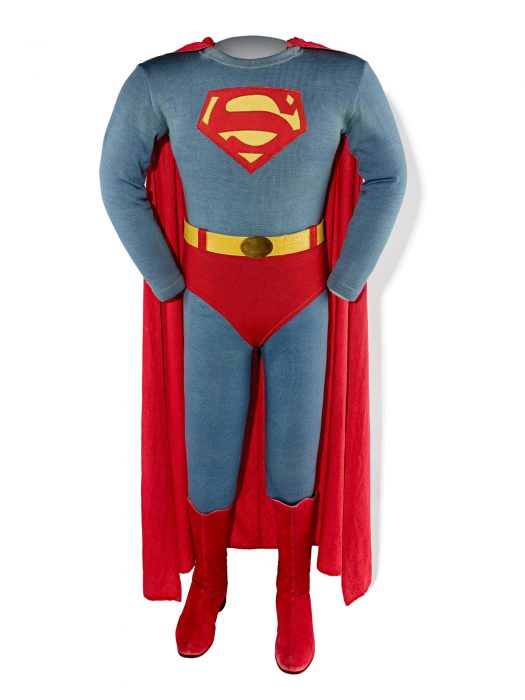
Superman Costume, worn by George Reeves on “The Adventures of Superman,” 1952 – 1958. Gift of DC Comics, Incorporated (through Paul Levitz)
America’s fascination with superheroes began in the midst of the Great Depression with the arrival of Superman on the pages of a comic book in 1938. Sent to Earth after the destruction of his home planet, Superman uses his special abilities—including super-strength and flight—to fight for “truth, justice, and the American way.” At the height of the Cold War against Communist expansion, Superman took his fight to television. George Reeves wore this costume on The Adventures of Superman, a syndicated children’s program that aired from 1952 to 1958.
Why did “super” characters in comic books become so popular in the 1930s?
Although a handful of super-powered characters predate him, Superman, created in 1939 by Jerry Siegel and Joe Shuster, was a sensation, defining the genre. Like most successful popular culture icons, Superman spoke to audiences of the time who were dealing with the fallout of the Great Depression and preparing for potential war. People loved the idea of someone with super powers fighting for the common man.
Superheroes have dominated the box office in recent years. Why do you think they still resonate so strongly with audiences today?
One of the strengths of superheroes is their ability to embrace mythological archetypes with narratives that are adapted and informed by contemporary life. Their adventures address conflicts universal to the human condition and allow audiences to engage with big issues and ideas in an approachable manner. Also…they are really cool!
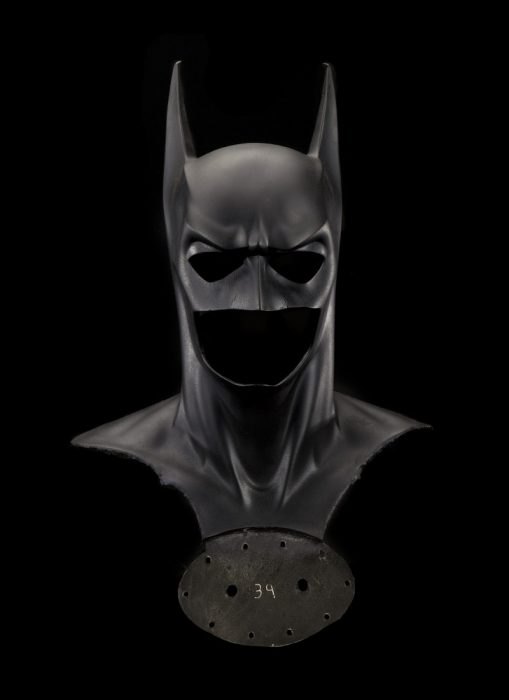
Cowl from the batsuit worn by George Clooney in the film “Batman and Robin”. The Warner Bros. Collection.
George Clooney wore this cowl in the 1997 film Batman and Robin. Unlike most superheroes, Batman lacks super abilities, instead fighting crime with his formidable will, intellectual prowess, and technological inventions such as the “batarang.” Created in the early days of the medium, the character has lent itself to constant reinterpretation, at times portrayed as comedic, grim—and even unhinged.
At any comic convention, you’ll see entire families dressed in costume. What is it about superheroes, in particular, that inspires such passionate fandom?
Entertainment is a way people of all ages can understand and engage with the world, and also explore and define themselves. It can create communities, bridge differences and spark conversation. I think the number of people attending comic cons and cosplaying (dressing up in costume) reveals the importance of superheroes to many members of the public, and how this interest is being actively used to bond with others.
One of the comics in the exhibition is “La Borinqueña,” a Puerto Rican superhero; another is “Ms. Marvel,” a Muslim superhero. What has driven this increasingly diverse representation in the pages of comic books and on the big screen?
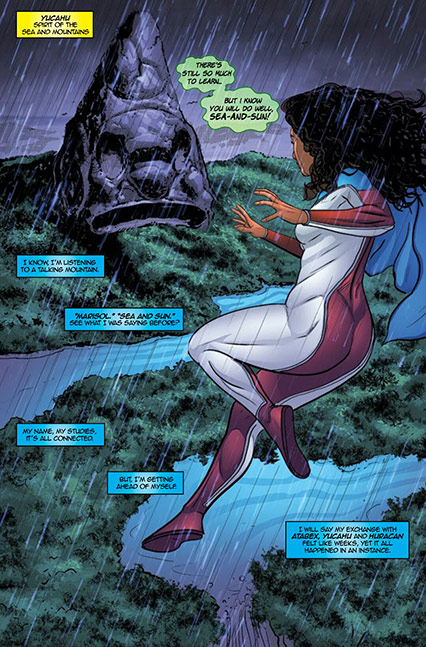
Comic book illustration from La Borinqueña #1, written and created by Edgardo Miranda-Rodriguez. Illustration by Will Rosado and digital colors by Juan Fernández. © 2016 Somos Arte, LLC
Courtesy National Museum of American History, gift of Eric Jentsch
Puerto Rican superhero La Borinqueña is shown during a mystical encounter with the powerful deity Yucahu, who appears as a mountain-sized version of a cemi, a type of ritual object. In the comic, she encounters other Native deities originally described in the 1498 chronicle An Account of the Antiquities of the Indians.
Well, I’m not a sociologist, sometimes I wonder if I’m even a curator! But I think that history has shown that representation is important. It makes sense that people want to see themselves, and to be seen by others, in popular entertainment. As generations of fans have now grown up with the medium, there has been more diversity in content creators as well. Of course, there is still a long way to go before American entertainment truly represents all people.
Curating exhibitions about popular entertainment seems as if it would be pretty entertaining. How did you wind up here?
I studied English literature and history as an undergrad at St. Louis University. I did well, but you could say I enjoyed my college career without giving much thought to the future. Realizing that I wasn’t interested in a straight-forward academic career, I enrolled in the museum studies program at George Washington University here in Washington, D.C. After graduation, I got a job at the National Museum of American History doing data entry for the Medical Sciences Department. I am lucky to have been encouraged to try new things, eventually leading to my current position as lead curator for the museum’s Entertainment and Sports collections. I’m both surprised and gratified about how things worked out!
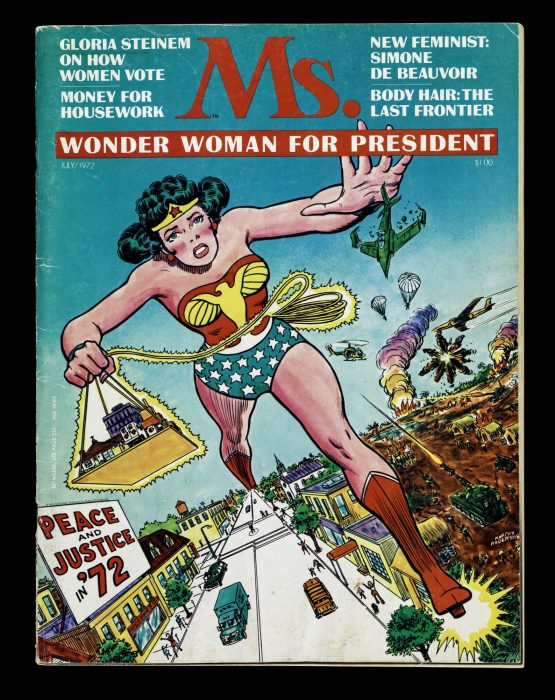
Ms. Magazine with Wonder Woman on cover, “Ms.” Volume I, No. 1. Gift of 20th Century Fox. Fox Domestic Theatrical (through Daria Vogel)
Since Wonder Woman’s origin in 1941, the Amazonian princess’s powerful combination of compassion and strength has inspired generations. She and other woman superheroes have proved to be powerful symbols for changing roles and expectations. They’ve also sparked conversations about the emphasis placed on the physical attractiveness of women characters—even as they’re trying to save the world.
What’s a typical day like for you?
That’s a tough question, which is why I love my job so much! I might be working on planning new exhibitions, negotiating with donors for new collections, giving an interview or doing research for publications or presentations. As a bonus, I get to meet with a wide variety of people, including researchers, government VIPS, interest groups, celebrities and kids.
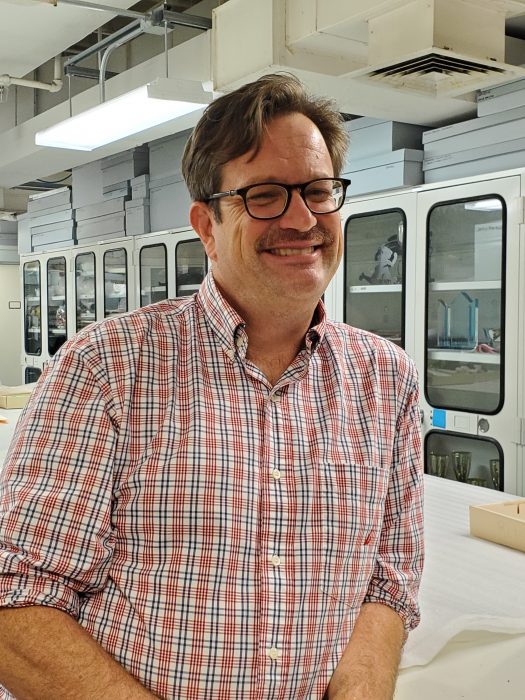
Eric Jentsch (Photo by Marilyn Scallan)
What would someone be surprised to learn about your job?
Well it won’t be a surprise to people at Smithsonian, but most people are surprised that we rarely purchase collections. We rely almost exclusively on donations in order to grow and diversify.
Is it more difficult to get donations with the advent of auction sites such as eBay?
Yes, sometimes. Often, we hear about important props or memorabilia only after they’ve been sold. The collector’s market has exploded, making auctions more common. However, we have had great success with many donors who understand the Smithsonian’s goals, including the importance of preserving and sharing these cultural materials with the public.
What would you like for people to take away from an exhibit or display that you curate?
That participation in popular culture is not merely escapism. It has the power to create personal meaning, and it is an essential and influential way in which we understand and connect with the world.
Posted: 4 December 2019
-
Categories:
American History Museum , Art and Design , Feature Stories , History and Culture







